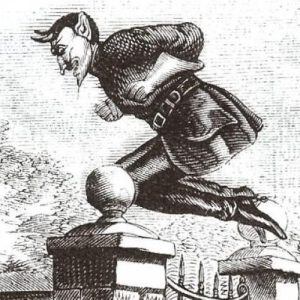
Spring Heeled Jack: The Leaping Terror of Victorian England
| Description | |
|---|---|
| Origin | England |
| Classification | Humanoid |
| Demeanour | Evil |
| Habitat | Urban Areas |
| Status | Not Proved |

Introduction
Spring Heeled Jack remains one of the most disturbing and mysterious figures in English folklore. Emerging from the shadowy streets of Victorian London in 1837, he was said to leap over rooftops, breathe blue fire, and assault unsuspecting victims before vanishing into the night. His uncanny agility and devilish appearance struck fear into Londoners, while sensational newspaper coverage turned him into a household name. Over time, the mystery surrounding his identity transformed him into both a symbol of urban terror and a fascinating figure of supernatural myth.
Physical Attributes
Eyewitness accounts of Spring Heeled Jack described a creature that was both human and otherworldly. He was typically portrayed as tall and thin, dressed in tight-fitting oilskin or metallic armor beneath a dark cloak. His eyes glowed a fierce red, piercing through the fog, and his hands ended in long, metallic claws capable of tearing fabric and flesh. Witnesses also spoke of his ability to breathe blue and white flames, illuminating his distorted, demonic face.
Some reports described him as a gentlemanly figure with a goatee and pointed ears, while others saw a horned demon whose skin shimmered gray under gaslight. What terrified people most, however, was his extraordinary ability to leap enormous distances—clearing walls, rooftops, and even church spires with inhuman ease. This uncanny power earned him the infamous nickname “Spring Heeled Jack,” a title that would echo through the corridors of British folklore for generations.
First Sighting/Reporting
The first reported sighting occurred in 1837, when a servant girl named Mary Stevens claimed that a strange figure leapt at her from a dark alley near Clapham Common. The man gripped her tightly, clawed at her clothes, and fled after she screamed for help. The next day, a similar figure appeared near her home, startling a carriage horse and causing an accident. Witnesses said the attacker escaped by leaping effortlessly over a nine-foot wall.
By early 1838, the story had spread across London. The Lord Mayor received letters describing similar incidents involving a mysterious fire-breathing man who attacked women in the suburbs. Newspapers sensationalized the tale, calling him “The Leaping Devil.” The most famous case involved Jane Alsop, who reported that a man claiming to be a policeman knocked on her door. When she brought him a candle, he revealed his horrifying face, spewed blue flames into her eyes, and tore at her gown with metallic claws before bounding away into the darkness. These encounters cemented Spring Heeled Jack’s place as one of Victorian London’s most infamous legends—a figure as feared as he was fascinating.
Other Names
Although “Spring Heeled Jack” became the definitive title, the phantom was known by several names throughout the 19th century. Locals called him “The Phantom Leaper,” “The Devil Jack,” “The Leaping Terror,” and “Steel Jack.” Some newspapers even dubbed him “The Suburban Ghost,” hinting at his spectral nature. Each name reflected the confusion over his true identity—was he a prankster, a ghost, or a supernatural demon? Regardless of what people believed, the name “Spring Heeled Jack” endured as the one that perfectly captured his eerie agility and infernal energy.
Modus Operandi
Spring Heeled Jack’s attacks followed a chillingly consistent pattern. He targeted primarily young women walking alone at night, often appearing suddenly from alleyways, courtyards, or even rooftops. Victims described his clawed hands tearing their clothes and his breath spewing blue fire into their faces. His laughter was high-pitched and maniacal, echoing long after he vanished.
In several accounts, he disguised himself as a police officer or gentleman to gain trust before attacking. When confronted or pursued, he would make a powerful leap and disappear, leaving witnesses speechless. His incredible mobility and apparent immunity to capture baffled authorities. Some speculated that he used hidden mechanical springs or experimental boots, while others insisted he was something far more sinister—a devil manifesting in human form.
What made his assaults terrifying was not just their violence but their theatricality. Every appearance was deliberate, every escape spectacular. Spring Heeled Jack seemed less a criminal and more a living nightmare designed to keep London awake in fear.
Pop Culture References
Spring Heeled Jack quickly became an icon of Victorian horror and urban mythology. He appeared in countless penny dreadfuls throughout the 1840s and 1850s, often reimagined as either a monstrous villain or a misunderstood anti-hero. As time passed, he evolved from a demonic attacker into a vigilante hero in serialized fiction, foreshadowing the birth of the modern superhero archetype.
His legend continued to inspire literature and art well into the modern era. Philip Pullman’s Spring-Heeled Jack reimagined him as a savior of orphans, while Mark Hodder’s The Strange Affair of Spring-Heeled Jack transformed him into a time-traveling enigma. The character has also appeared in plays, graphic novels, and films such as The Curse of the Wraydons. In gaming, Assassin’s Creed: Syndicate featured a series of missions based on his legend, keeping his ghost alive for new generations.
Even in music and podcasts, his tale continues to echo. Artists and storytellers see in him a symbol of mystery, chaos, and the thin line between folklore and reality.
Current Status
The true identity of Spring Heeled Jack remains one of Britain’s greatest unsolved mysteries. Sightings gradually declined after the late 19th century, though reports continued into the early 1900s. The final major sighting occurred in Liverpool in 1904, where townspeople claimed to see a cloaked figure bounding across rooftops before vanishing into the night.
Modern researchers have suggested numerous theories—from aristocratic pranksters using mechanical gadgets to mass hysteria fueled by sensational journalism. Others believe the legend drew on older English folklore about trickster spirits and demons. While rational explanations abound, none fully capture the eerie consistency of the reports or the fear they inspired.
Today, Spring Heeled Jack exists as a cultural phantom—half myth, half man—haunting the pages of history and the imagination of those who still walk London’s misty streets. His story endures not just as a tale of terror but as a mirror reflecting Victorian fears of the unknown, technology, and the darkness within human nature itself.
Source
Historic UK. (2024, January 10). Spring Heeled Jack. https://historic-uk.com/CultureUK/Spring-Heeled-Jack/
Atlas Obscura. (n.d.). Meet Spring-Heeled Jack, the Leaping Devil That Terrorized Victorian England. https://atlasobscura.com/articles/spring-heeled-jack-history
BBC History Extra. (2025, June 25). Was Spring-Heeled Jack Real? https://historyextra.com/period/victorian/spring-heeled-jack-myth-folklore-history-facts/
Sussex Folktale Centre. (n.d.). The Mystery of Spring-Heeled Jack: From Victorian Legend to … https://sussexfolktalecentre.org/spring-heeled-jack
Wikipedia. (2005, March 6). Spring-heeled Jack. https://en.wikipedia.org/wiki/Spring-heeled_Jack
Landsurvival.com. (2007, December 31). Spring Heeled Jack – Survival. https://landsurvival.com/2007/12/31/spring-heeled-jack-survival/
Wikipedia. (2006, July 21). Spring-heeled Jack (disambiguation). https://en.wikipedia.org/wiki/Spring-heeled_Jack_(disambiguation)
Sky HISTORY. (n.d.). England’s most notorious urban legend: The mystery of Spring-Heeled Jack. https://www.history.co.uk/articles/the-mystery-of-spring-heeled-jack
HistoryExtra. (2025). Was Spring-Heeled Jack Real?. https://www.historyextra.com/period/victorian/spring-heeled-jack-real-ghost-phantom/
Rickard, B. (2001). Spring-Heeled Jack: The Terror of London. Fortean Times. https://www.forteantimes.com/spring-heeled-jack
Radford, B. (2014). Spring-Heeled Jack: The Leaping Legend of Victorian England. LiveScience. https://www.livescience.com/spring-heeled-jack-legend
Clarke, D. (2012). Supernatural England: Spring-Heeled Jack and Other Legends. British Folklore Society. https://www.folklore-society.com/spring-heeled-jack
Haining, P. (1977). The Legend and Bizarre Crimes of Spring-Heeled Jack. Frederick Muller Ltd. https://archive.org/details/springheeledjack-haining
Frequently Asked Questions
Was Spring Heeled Jack based on a real person?
No definitive proof exists, though some theories suggest he may have been an aristocratic prankster or a figure of mass hysteria.
Why did people believe Spring Heeled Jack was supernatural?
His alleged ability to leap great heights, breathe fire, and disappear led many to think he was demonic or ghostly.
What was the most famous attack by Spring Heeled Jack?
Jane Alsop’s 1838 encounter, where he breathed blue flames into her face, is the most well-documented and sensational case.
Did authorities ever catch Spring Heeled Jack?
Despite numerous reports and investigations, no one was ever arrested or conclusively linked to the attacks.









